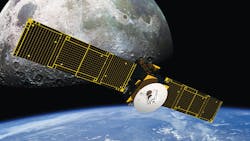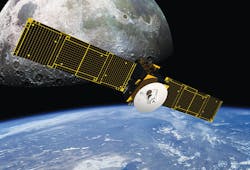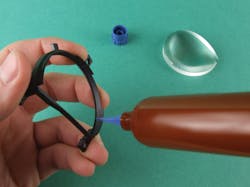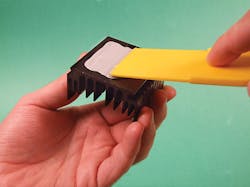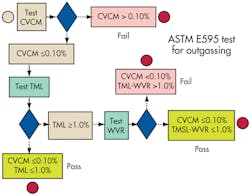Epoxies and adhesives fit for space
This file type includes high resolution graphics and schematics.
Satellites and spacecraft must survive and operate in an environment entirely different from that on Earth. There is no atmosphere to protect them from radiation or provide a blanket of warmth. Instead, they must put up with extreme hot and cold temperatures, exotic forms of some common materials and elements, and high vacuum conditions. For some space-bound components, such as propulsion subsystems and certain experimental devices on the International Space Station, they must withstand exposure to cryogenic temperatures as low as 4°K. These factors impose a strict set of constraints on spacecraft equipment and materials.
Depending on where a spacecraft is headed, additional environmental factors may affect its design. In low-Earth orbits, where space stations and most artificial satellites are deployed, there is highly reactive atomic oxygen (AO). Higher up, in geostationary orbits where communications and weather satellites operate, particulate radiation (protons, electrons, and heavy ions) can cause problems. And in interplanetary regions and deep space where space probes travel, high temperatures and intense radiation are of particular concern.
Problems with adhesives in space
Adhesives and other polymers are used extensively in all types of spacecraft for structural, mechanical, and electronics purposes — including bonding, potting, encapsulating, coating, sealing, and staking. Most adhesives used on spacecraft are not exposed to atomic oxygen or ionizing radiation because they are inside or sandwiched and protected between parts they are holding together. But whether directly exposed to space or not, most adhesives employed in space applications are subject to high vacuum and extreme cold. They must function properly despite the surrounding conditions without degrading other spacecraft components.
Adhesives on spacecraft are often near electronic or optical devices, where contamination can lead to serious problems. For example, many adhesives outgas, potentially releasing volatile products which condense and contaminate electronic, optical, and other precision instruments. Outgassed compounds can cloud or fog optical and electro-optical components and interfere with circuit continuity. Even tiny amounts of condensed organic material can alter the reflectivity or absorbency of optical components. Precise control over outgassing levels is critical in preventing contaminant deposits and the resulting loss of performance to mission-critical subsystems.
Requirements for adhesives
Adhesives for space applications must function in high vacuums, extremely low temperatures, and withstand temperature fluctuations. Their bonds should also last the length of the mission. Adhesives directly exposed to space for long periods of time should also strongly resist radiation and microcracking and, if in a low-Earth orbit, also resist atomic oxygen. That’s because radiation can make some adhesives brittle, ultimately resulting in cracks. And lengthy exposure to AO can erode adhesives.
Other application-specific requirements include electrical conductivity, optical clarity, thermal conductivity or insulation, low ionic content, and cryogenic serviceability.
But all adhesives designated for space applications must meet the outgassing acceptance criteria defined in NASA specification SP-R-0022A, Vacuum Stability Requirements of Polymeric Material for Spacecraft Application. This specification stipulates that the total mass lost from a polymer-based adhesive specimen in a vacuum shall not exceed 1% of its original mass and that collected volatile condensable materials shall not exceed 0.10% of the original specimen mass. An addendum states that the total mass lost may exceed 1.0% if it can be shown that mass lost in excess of 1.0% was made up of water vapor.
Measuring outgassing
Researchers at NASA developed a standard test procedure, ASTM E595: A standard test method for total mass lost and collected volatile condensable materials from outgassing in a vacuum environment, to determine the mass lost in a vacuum and collect the outgassed products. This procedure also measures the volatile content of adhesives in a heated vacuum chamber.
Specimens are kept at 25°C, 50% humidity, and standard atmospheric pressure for 24 hr prior to the test to ensure all specimens are prepared the same. Samples are then weighed and placed in individual compartments within a solid copper heater bar, with separate covers for each compartment. An exit port in each cover provides the only means for volatile gases to escape, and a collector plate is placed 0.5 in. from each port. Barriers separate neighboring plates.
The heater bar is placed in a test chamber where the pressure is 5 × 10-5 torr or less. Both the samples and copper bar are heated to 125°C for 24 hr, driving off volatile gases through the exit port. With the temperature of the collector plate set to 25°C, a significant portion of the volatile material condenses on the plate. The total mass lost (TML) for each specimen is calculated as a percentage by comparing the weight of the specimen before and after the test. The collected volatile condensable material (CVCM) for each specimen is calculated as a percentage by comparing the weight of the clean collector plate to that of the collector plate after the test.
If CVCM does not exceed 0.10% and TML does not exceed 1.0%, the material passes the test. If CVCM exceeds 0.10% — regardless of TML — the material fails. However, if CVCM is less than 0.10%, but TML exceeds 1.0%, a further measurement is made to see how much water vapor the specimen can reabsorb after reconditioning exposure, which takes place in a chamber with 50% relative humidity at 25°C for an additional 24 hr. The water vapor regained (WVR), expressed as a percentage, represents the mass of water vapor recovered compared to the mass of the original specimen. If the difference between the TML and WVR does not exceed 1.0% (and CVCM does not exceed 0.10%), the material passes the test.
To summarize the results of ASTM E595:
- If CVCM ≤ 0.10% and TML ≤ 1.0%, the material passes.
- If CVCM ≤ 0.10% and TML > 1.0%, the material can pass if TML – WVR ≤ 1.0%.
- If CVCM > 0.10%, the material fails.
- If TML – WVR > 1.0%, the material fails.
It’s important to note that test results are only applicable to adhesives with the same chemistry that have undergone the same curing schedule.
There are other tests for outgassing, many of them proprietary, but they are not considered credible. ASTM E595 is the only widely accepted industry standard for quantifying outgassing in epoxies and other adhesives. The 24-hr test does have limitations. For example, it doesn’t predict long-term outgassing performance or reveal what will be outgassed under operating conditions. The test does, however, give engineers a way to evaluate adhesives on the basis of outgassing.
Low-outgassing adhesives and polymers are screened for use in space through a standard test known as ASTM E595 (see sidebar). Passing this outgassing test is a necessary — but not always sufficient — criterion for adhesives on spacecraft or equipment destined for use in space. For example, an adhesive that meets NASA’s outgassing criteria may not always be appropriate for use near devices operating in cryogenic temperatures.
Some adhesives, such as two-part epoxies, can be specially formulated to outgas at levels well below the ASTM E595 standard. There are also some adhesives that were once unable to pass that test, such as UV-curable adhesives. Recently, however, chemists have cracked the code of UV curables and concocted several that meet the test.
Adhesives that outgas most severely cure using solvents or moisture. These include several pressure-sensitive and contact adhesives as well as cyanoacrylates.
It’s worth noting that even within a given family of adhesives, outgassing can vary substantially. For example, the more-flexible epoxies are more prone to outgassing due to their lower cross-link density than their more-rigid counterparts. So adhesives should be evaluated for outgassing individually rather than as families. And the only way to know for certain whether a specific adhesive meets the low outgassing criteria spelled out in ASTM E595 is to test it.
Epoxies for space
The dual challenge of achieving sufficiently low-outgassing levels while offering physical properties that suit a variety of applications can be easily overcome by selecting certain epoxies. Epoxies are versatile polymer compounds that offer excellent cohesion, resist chemicals, adhere well to a variety of materials, and operate over temperatures ranging from cryogenic (4°K) to 550°F. As mentioned earlier, outgassing varies tremendously across epoxies. Numerous grades of one and two-part epoxies have been specially formulated to meet or exceed NASA’s outgassing specification. Epoxies that have passed ASTM E595 can provide a combination of electrical conductivity, cryogenic serviceability, optical clarity, thermal conductivity or insulation, and resistance to vibrations, thermal shocks, or impacts.
Epoxies can be engineered to have a variety of mechanical, thermal, optical, electrical, and physical properties to match an application’s requirements. Adding inorganic fillers, for example, can alter an epoxy’s strength, viscosity, thermal expansion, heat and chemical resistance, electrical and thermal conductivity, and shrinkage.
One-part epoxies require no mixing but usually need heat to cure or improve their performance. Most two-part epoxies cure at ambient temperatures once mixed. Heat increases a polymer’s cross-link density which, in turn, limits outgassing, so adding a heat cycle after applying an adhesive can prevent future problems. For instance, after curing a two-part adhesive at room temperature overnight, an additional three to five hours or more at 60 to 80°C completes the cure and improves its outgassing properties.
Edited by Stephen J. Mraz, [email protected]
Resources: Master Bond Inc.
This file type includes high resolution graphics and schematics.
